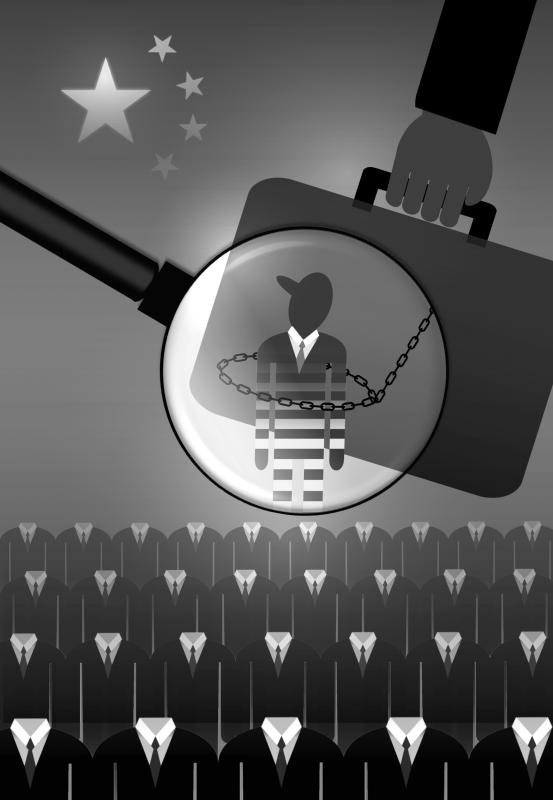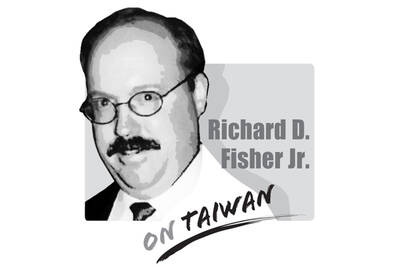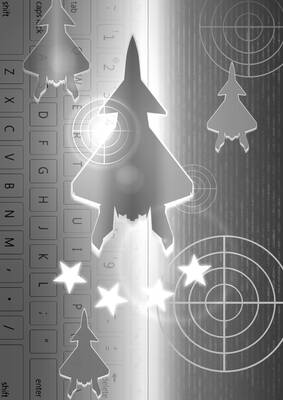It has been 11 weeks since Lai Xiaomin (賴小民), the man once known as the God of Wealth, was executed on a cold Friday morning in the Chinese city of Tianjin.
However, his shadow still hangs over one of the most dramatic corruption stories ever to come out of China — a tale that has now set nerves on edge around the financial world.
At its center is China Huarong Asset Management Co, the state financial company that Lai lorded over until getting ensnared in a sweeping crackdown on corruption by Chinese President Xi Jinping (習近平).

Illustration: Yusha
From Hong Kong to London to New York, questions burn: Will the Chinese government stand behind US$23.2 billion that Lai borrowed on overseas markets — or will international bond investors have to swallow losses? Are key state-owned enterprises like Huarong still too big to fail, as global finance has long assumed — or will these companies be allowed to stumble, just like anyone else?
The answers would have huge implications for China and markets across Asia. Should Huarong fail to pay back its debts in full, the development would cast doubt over a core tenet of Chinese investment: the assumed government backing for important state-owned enterprises, or SOEs.
“A default at a central state-owned company like Huarong is unprecedented,” said Owen Gallimore, head of credit strategy at Australia & New Zealand Banking Group.
Should one occur, it would mark “a watershed moment” for Chinese and Asian credit markets, he said.
Not since the Asian financial crisis of the late 1990s has the issue weighed so heavily. Huarong bonds — among the most widely held SOE debt worldwide — fell to a record low of about 52 cents on the dollar. That is not the pennies on a dollar normally associated with deeply troubled companies elsewhere, but it is practically unheard of for an SOE.
Time is short. All told, Huarong owes bondholders at home and abroad the equivalent of US$42 billion. About US$17.1 billion of that falls due by the end of next year, according to Bloomberg-compiled data.
It was not supposed to be this way. Huarong was created in the aftermath of the 1990s Asian collapse to avert another crisis, not cause one. The idea was to contain a swelling wave of bad loans threatening Chinese banks. Huarong was to serve as a “bad bank,” a safe repository for the billions in souring loans made to state companies.
Along with three other bad banks, Huarong swapped delinquent debts for stakes in hundreds of big SOEs and, in the process, helped turn around chronic money-losers like the giant China Petroleum & Chemical Corp.
After Lai took over in 2012, Huarong reached for more, pushing into investment banking, trusts, real estate and positioning itself as a key player in China’s US$54 trillion financial industry.
Before long, global banks came knocking. In 2013, for instance, Shane Zhang (張欣), cohead of Asia-Pacific investment banking at Morgan Stanley, met with Lai.
Zhang said his company was “very optimistic” about the future of Huarong, according to a statement posted on Huarong’s Web site at the time.
Before Huarong went public in Hong Kong in 2015, it sold a US$2.4 billion stake to a group of investors including Warburg Pincus, Goldman Sachs Group and Malaysia’s sovereign wealth fund. BlackRock Inc and Vanguard Group acquired lots of stock too, according to data compiled by Bloomberg. The stock has collapsed 67 percent since its listing.
Lai had no trouble financing his grand ambitions. A big reason: Everyone thought Beijing would always stand behind a key company like Huarong. It easily borrowed money in the offshore market at rates as low as 2.1 percent. It borrowed still more in the domestic interbank market. Along the way Lai transformed Huarong into a powerful shadow lender, extending credit to companies that banks turned away.
The truth was darker. Lai, a former senior official at the nation’s banking regulator, doled out loans with little oversight from his board or risk management committee.
One Huarong credit officer said Lai personally called the shots on most of the offshore corporate loans underwritten by her division.
Money also flowed to projects disguised as parts of China’s push to build railroads, ports and more around the world — the so-called Belt and Road Initiative, an executive at a state bank said.
Huarong did not immediately reply to questions on its lending practices.
Given Lai’s fate, both people spoke on the condition of anonymity.
Huarong snapped up more than half of the 510 billion yuan (US$23 billion at the current exchange rate) in distressed debts disposed of by Chinese banks in 2016.
At its peak, Lai’s sprawling empire had almost 200 units at home and abroad. He boasted in 2017 that Huarong, having reached the Hong Kong Stock Exchange, would soon go public in mainland China, too.
The initial public offering never happened. Lai was arrested in 2018 and subsequently confessed to a range of economic crimes in a state TV show. He spoke of trunkloads of cash being spirited into a Beijing apartment he had dubbed “the supermarket.”
Authorities said they discovered 200 million yuan there. Expensive real estate, luxury watches, art, gold — the list of Lai’s treasure ran on.
In January, Lai was found guilty by the Secondary Intermediate People’s Court in Tianjin of accepting of US$277 million in bribes between 2008 and 2018. He was put to death three weeks later — a rare use of capital punishment for economic crimes.
Some took the execution as a message from Xi: My crackdown on corruption will roll on.
At Huarong, the bottom has fallen out. Net income plummeted 95 percent from 2017 to 2019, to 1.4 billion yuan, and then sank 92 percent during the first half of last year. Assets have shriveled by 165 billion yuan.
The company on April 1 announced that it would delay its results for last year, saying its auditor needed more time.
The influential Caixin magazine last week openly speculated about Huarong’s fate, including the possibility of bankruptcy. Its credit outlook was put on review for a potential downgrade by all three top rating firms.
According to people familiar with the matter, Huarong has proposed a sweeping restructuring. The plan would involve offloading its money-losing, non-core businesses. Huarong is still trying to get a handle on what those businesses might be worth.
The proposal, which the government would have to approve, helps explain why the company delayed its results, the people said.
Company executives have been meeting with peers at state banks to assuage their concerns over the past two weeks, a Huarong official said.
The Chinese Ministry of Finance has raised another possibility: transferring its stake in Huarong to a unit of the nation’s sovereign wealth fund that could then sort out the assorted debt problems.
Regulators have held several meetings to discuss the company’s plight, people familiar with the matter said.
In an e-mailed response to questions from Bloomberg, Huarong said it has “adequate liquidity” and plans to announce the expected date of its earnings release after consulting with auditors.
China’s banking and insurance regulator did not immediately respond to a request seeking comment on Huarong’s situation.
One thing is sure: Huarong is part of a much bigger problem in China. State-owned enterprises are shouldering the equivalent of US$4.1 trillion in debt and a growing number of them are struggling to keep current with creditors.
In all, Chinese SOEs reneged on a record 79.5 billion yuan of local bonds last year, lifting their share of onshore payment failures to 57 percent from just 8.5 percent a year earlier, Fitch Ratings has said.
The figure jumped to 72 percent in the first quarter of this year.
The shockwaves from Huarong and these broader debt problems have only begun to reverberate through Chinese finance. Dismantling all or part of Lai’s old empire would show Beijing is willing to accept short-term pain to instill financial discipline among state-owned enterprises.
The irony is that Huarong was supposed to fix China’s big debt problem, not cause a new one.
“Allowing a state-owned financial institution that undertook the task of resolving troubles of China’s financial system to fail is the worst way to handle risks,” said Feng Jianlin (馮建林), a Beijing-based chief analyst at research institute FOST. “The authorities must consider the massive risk spillover effects.”

As the Chinese Communist Party (CCP) and its People’s Liberation Army (PLA) reach the point of confidence that they can start and win a war to destroy the democratic culture on Taiwan, any future decision to do so may likely be directly affected by the CCP’s ability to promote wars on the Korean Peninsula, in Europe, or, as most recently, on the Indian subcontinent. It stands to reason that the Trump Administration’s success early on May 10 to convince India and Pakistan to deescalate their four-day conventional military conflict, assessed to be close to a nuclear weapons exchange, also served to

The recent aerial clash between Pakistan and India offers a glimpse of how China is narrowing the gap in military airpower with the US. It is a warning not just for Washington, but for Taipei, too. Claims from both sides remain contested, but a broader picture is emerging among experts who track China’s air force and fighter jet development: Beijing’s defense systems are growing increasingly credible. Pakistan said its deployment of Chinese-manufactured J-10C fighters downed multiple Indian aircraft, although New Delhi denies this. There are caveats: Even if Islamabad’s claims are accurate, Beijing’s equipment does not offer a direct comparison
After India’s punitive precision strikes targeting what New Delhi called nine terrorist sites inside Pakistan, reactions poured in from governments around the world. The Ministry of Foreign Affairs (MOFA) issued a statement on May 10, opposing terrorism and expressing concern about the growing tensions between India and Pakistan. The statement noticeably expressed support for the Indian government’s right to maintain its national security and act against terrorists. The ministry said that it “works closely with democratic partners worldwide in staunch opposition to international terrorism” and expressed “firm support for all legitimate and necessary actions taken by the government of India
Minister of National Defense Wellington Koo (顧立雄) has said that the armed forces must reach a high level of combat readiness by 2027. That date was not simply picked out of a hat. It has been bandied around since 2021, and was mentioned most recently by US Senator John Cornyn during a question to US Secretary of State Marco Rubio at a US Senate Foreign Relations Committee hearing on Tuesday. It first surfaced during a hearing in the US in 2021, when then-US Navy admiral Philip Davidson, who was head of the US Indo-Pacific Command, said: “The threat [of military